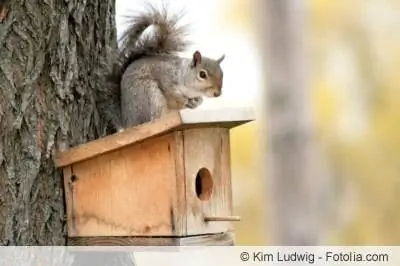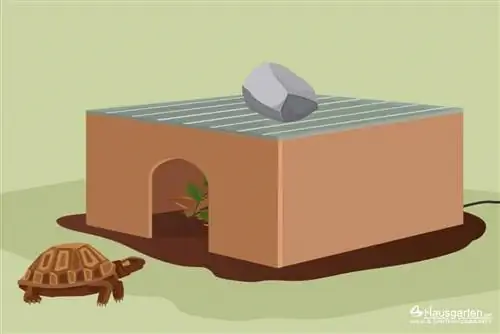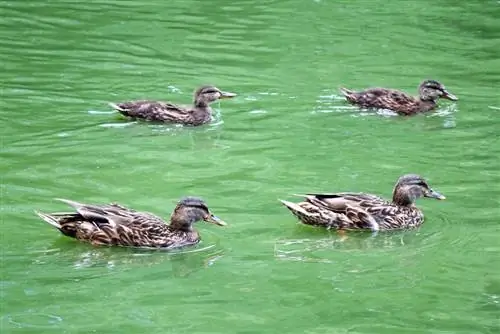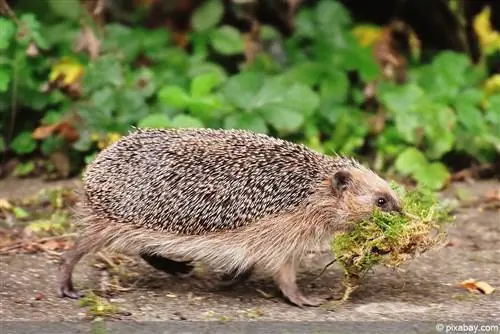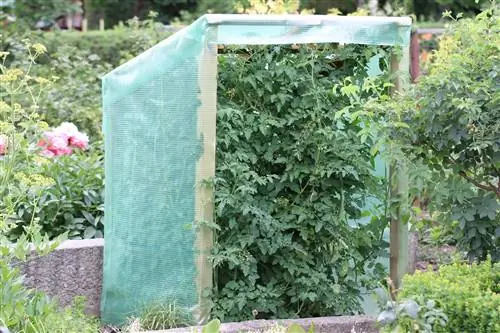- Author admin [email protected].
- Public 2023-12-17 03:39.
- Last modified 2025-01-24 12:45.
The European squirrel with its unmistakable red fur color has become rare in our gardens. If you want to house these cute fur balls in your green kingdom, you can offer them a ready-to-move-in nest. If this cob is stable enough to raise the offspring and spend the winter rest in, the squirrel will move in. In order for the nest to withstand the intensive scrutiny of the little garden acrobats, various factors must be taken into account. The following instructions explain how you can build a squirrel house yourself and hang it up correctly.
Important framework conditions
Squirrels build extremely stable, weatherproof nests. They place these in hollow tree trunks or in the forks of branches, high up in treetops. The 15-20 centimeter small and 200-400 gram light squirrels place the highest value on safety and create at least one additional escape route should a marten besiege the main entrance. The popular garden animals are not afraid to colonize an abandoned hawk or magpie nest and redesign it according to their own wishes. Hobby gardeners have the best chance of attracting little guests into the garden with a self-built squirrel house if the construction meets the following requirements:
- The wood used is at least 2 cm thick (chipboard is completely unsuitable)
- Untreated softwoods, such as maple, beech or pine are recommended
- A biologically based glaze serves as moisture protection
- The base area is not smaller than 26 x 26 cm
- The height should not be less than 30 cm
- The roof rises above the ground by a few centimeters to prevent rain from coming in
- Ideally, the cover is designed to be movable using hinges
- Roofing felt allows pelting rain to roll off
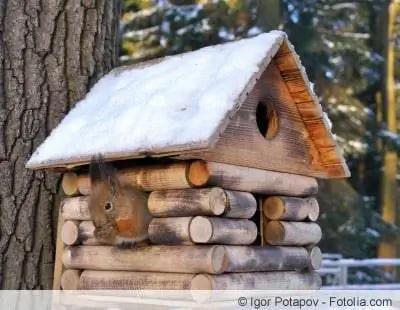
The perfect squirrel house has at least 2 entrances and exits in the form of round holes with a diameter of 7-8 cm so that even a pregnant female squirrel can fit through. One of these exits points downwards and is as close as possible to the tree trunk so that the animals can escape quickly in an emergency. The main entrance is built a little above ground level so that there is still enough space behind it for comfortable floor padding. A platform in front of the entrance is not absolutely necessary, as the agile climbing artists can find support anywhere as long as it is not a smooth, painted surface. A pitched roof may look decorative, but it will not please the cute residents. Squirrels love to sit or stretch out on the roof of their nests. A flat roof is therefore more advantageous and easier to construct.
Tip:
Holes with a diameter of 12 mm drilled in the side walls prevent heat build-up in summer and the formation of condensation.
The perfect upholstery
You can let the squirrels decorate the interior or put the upholstery on ready to make the furniture particularly inviting. Suitable materials include moss, straw, wood wool, feathers, thin branches and sheep's wool. How to do it right:
- Cover the floor with wood wool or straw
- Spread the soft sheep's wool or feathers over it
- Clench one hand into a fist, stick it through the entrance and form a hollow
- Fill the nest with the remaining material from above, pull out your hand and close the lid
- The squirrel does the fine work himself
The material used is of course free of any chemical substances, which particularly applies to the wood wool. If you use used upholstery wool instead of sheep's wool, there should be no long threads that could strangle the squirrel.
Tip:
Squirrels are usually not satisfied with a single nest, but inhabit several nests. Therefore, offer your fluffy garden inhabitants several houses, as the pregnant females in particular like to move to a fresh nest shortly before giving birth.
Hang the squirrel house correctly
Squirrels have to deal with natural enemies such as cats and martens. Since these opponents are also first-class climbers, the Kobel should be hung 4 to 5 meters high in a treetop. The higher you can position the house, the safer it is for the little residents. Of course, you shouldn't neglect your own safety.
- The best time to hang a kobel is before mating season
- Squirrel mating season is February/March and June/July
- A branch fork offers the best grip and easy access for the animals
- Weatherproof cords and tension straps are used as fastening materials
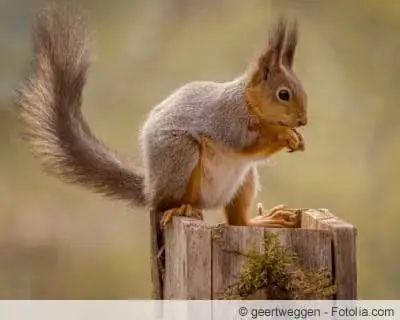
It is an advantage to hang the squirrel house so that it can be removed for cleaning and refilling. If a nest is infested with parasites, it is usually abandoned immediately. In this case, take the Kobel out of the tree and burn it with an open flame.
Build your own feeding house
Squirrels never use their nest to store food. Instead, the busy animals collect nuts, seeds, corn kernels, raisins and other food and bury it in various places in the garden. Increasing urbanization means that the cute animals can no longer find enough food in the fall to build up a sufficient winter supply. They help the squirrels a lot if there is a bird feeder in the garden in addition to the bird feeder. How to build the feeder yourself:
- The feeding box consists of a base plate that is extended towards the front and side walls
- The extension acts as a seat so that the squirrel can easily access the food
- The front consists of a viewing window made of Plexiglas, which is attached to the inside of the walls using grooves
- The side walls slope slightly towards the front and are at the same time slightly offset inwards
- There is a hinged lid on the side walls, which is connected to the back wall by hinges
- A rain bar covers the hinges so that the lid cannot be opened completely and it does not rain in
It is important to note that the viewing window on the top is shortened. This gap serves to ventilate the food so that mold does not form here. Above all, it prevents the dangerous guillotine effect if a second squirrel jumps onto the lid while the first one sticks its head in the feeder.
A cost-effective version of the feeder can be built using a spruce glued wood panel measuring 120 x 20 centimeters. Solid larch wood, which is significantly more weather-resistant than pine, is particularly suitable. If you sand the surface smooth and then impregnate it with natural beeswax, you and the squirrels will enjoy the self-made feeding station for many years. In this case, it is recommended to use connections and fittings made of stainless steel instead of a normal galvanized version. If you want a colored design, only solvent-free, water-based paint should be used, because squirrels will nibble on anything if they get under their teeth.
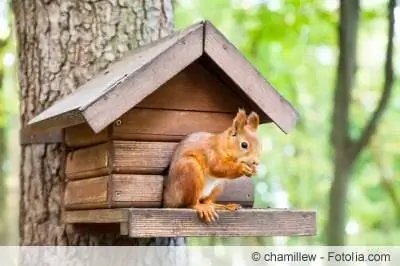
Tip:
Don't overestimate the power of little squirrels. The hinged lid of a food box should be as smooth as possible. A squirrel can only lift the cover slightly with your little finger.
Hang up the food box
In contrast to the squirrel house, a feeding station does not have to be hung meters high in a treetop. It would simply be too inconvenient to fill them, which can be the case every day in a harsh winter. Hang the feeder from a nail on the tree trunk so high that you can easily reach it from either the ground or the ladder.
Conclusion
Squirrels are increasingly dependent on our help. This also applies to support in building nests and to creating food supplies in the winter. A Kobel should be weatherproof and safe. At least two entrances and exits provide good escape options if the nest is invaded by a marten or a cat. The use of only natural materials is mandatory. If you want, you can not only build the squirrel house yourself, but also furnish it comfortably with soft padding made of straw, wood and sheep's wool or feathers. Since the cute garden animals always place their nests high up in the treetops, the structure you construct yourself should be hung at least 4 meters high in a sturdy fork of a branch. For an automatic feeder, this height is not necessarily necessary so that replenishment can be easily provided at any time.

